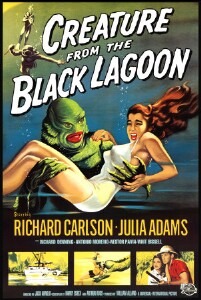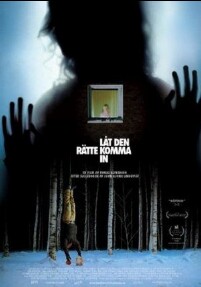It recently struck me how most of the films that, IMHO, were truly scary were the ones that had little or no digital special effects. The reason is simple: what makes something scary is mostly what you don’t see rather than what you do see.
 Compare, for example, Alien (1979) with it’s putative prequel, Prometheus (2012). While Alien won an Oscar for special effects, by today’s standards the SFX technology is relatively crude, not all that different from the rubber suits in The Creature from the Black Lagoon (1954).
Compare, for example, Alien (1979) with it’s putative prequel, Prometheus (2012). While Alien won an Oscar for special effects, by today’s standards the SFX technology is relatively crude, not all that different from the rubber suits in The Creature from the Black Lagoon (1954).
Prometheus had lavish digital special effects, but Alien is a much scarier film partly because the eponymous creature is only on the screen for a few minutes. The horror comes not from watching what the alien actually does but in the anticipation of what it might do next.
 Here’s another example. The Swedish film Let the Right One In and the American remake Let Me In were both good films, and share almost identical scenes and even camera shots. The acting is comparable (the parts are fairly one-note) but the remake suffers from several scenes show the vampire as what appears to be some kind of bargain basement Gollum.
Here’s another example. The Swedish film Let the Right One In and the American remake Let Me In were both good films, and share almost identical scenes and even camera shots. The acting is comparable (the parts are fairly one-note) but the remake suffers from several scenes show the vampire as what appears to be some kind of bargain basement Gollum.
Other examples come to mind. The Haunting (1963) is a truly frightening film even though its only special effect is a bulging door. The 1999 remake, though chockablock with special effects, is utterly forgettable, in part, I think, because it attempted to show what was hidden in the original film.
On a personal note, I once had a long conversation at a Hollywood party with Russ Tablyn, who played the “brash young man” in The Haunting. I recall that he explained how he did all of his own stunts, which was unusual in those days.
As far as I can recall, the only horror film remake that stands up next to the original is the 1979 Nosferatu, based on the groundbreaking 1922 silent film. In this case, the remake works because the director Werner Herzog didn’t muck around much with special effects, but instead consciously imitated the “look and feel” of the original film.
 I think part of the problem is that special effects were originally both expensive and difficult to do well, which forced filmmakers to use them sparingly and concentrate more on plot and character development.
I think part of the problem is that special effects were originally both expensive and difficult to do well, which forced filmmakers to use them sparingly and concentrate more on plot and character development.
Too much dependence on special effects is particularly fatal to horror films, though, and I’ve come to the conclusion that filmmakers who overuse them are trying to paper over a basic lack of talent. It’s difficult to construct empty spaces of dread but easy to be grotesque with gore.
If I might draw a parallel, it’s more fun to be seduced than to get laid. And that’s what really good horror films do — they seduce you into feeling the apprehension of the characters rather than shoving your face into a faked-up reality.











This is also a "cultural divide" between Hollywood and the rest of the world. Hollywood horror films for the last 20 years (if not more) have had huge budgets compared to horror directors elsewhere, and if they have the money, they're going to use it. Compare that to say Japanese horror movies,where they have tiny (in comparison) budgets so they have to rely on things like "plot development" and "building an atmosphere" to scare people – things Hollywood generally gets around by spending more $$ in adding more red paint or another CGI monster. I can't remember the last hollywood film that made me hesitate for a minute as I was turning of the lights at night, but I can think of 2 japanese ones without much effort ("Ringu" and "Ju-On", both poorly remade by Hollywood later on).
For the "rest of the world" I'm not just talking about outside of the US, I'm also talking about small indie films in the US itself. One of the more genuinely scary movies of the late 90s/early 2000s was The Blair Witch Project, which was made on a shoestring budget.
So, instead of saying the issue is "too much reliance on special effects", you could say that the issue is having too much money to spend – when it comes to Horror flicks, less is more….
Another example is The Impossible Planet/The Satan Pit from the 2nd season of the new Doctor Who. The Impossible Planet is easily he scariest and darkest episode of any Doctor Who I have watched (mostly the "new" Doctor Who, though I made a dash into some of the old seasons, especially the Tom Baker ones). It gets by on minimal special effects – the scariest moment is achieved with a bit of body paint and a couple of coloured contact lenses! Plus an appropriate musical cue (never underestimate the part the soundtrack plays in making a movie real scary). – By the time we actually see the monster, it is almost a bit of a let down (though it was a pretty good job) – it sort of works though, because we are explicitly told that this is only the BODY of the evil thing, its spirit has already escaped and found another host.
Same also goes for explicit sex on screen (as far as I'm concerned, at least!) I get very bored by seeing, or reading about, intimate gymnastic contortions in explicit detail. I find a Bollywood movie, where everything is suggested and nothing shown, much sexier than one of those European movies where the main characters spend half their screen time on top of each other — maybe that' s just me.
It's what Steve said — everyone is scared of different things, and moreover, mostly we are scared of the things we DO NOT KNOW.
Everyone also likes to do different things with their boy- or girlfriend. 😀
Thanks for using TCFTBL as your example- I love that movie.
What you're touching On I believe goes deeper and also, I think, marks a cultural divide.
less SFX means (or should mean) more reliance on the viewer's own powers of imagination. Any of us can scare ourselves far better than any film ever could.
The generation making film now largely grew up in an era when entertainment could not "show you what the monster looked like" (cheesey at best) and those folks have spent a lifetime perfecting the technologies that allow them to actually see what is inside their heads.
And that's the big problem. Auduences today watching a film with lots of SFX see what is in the director's head – not their own.
Rather than participating by using their own imaginations to fill in the blanks, they are being spoon fed. As a consequence, I think that they are growing up with atrophied senses of wonder – and may very well be incapable of appreciating (at least at the box office) a film that requires them to particpate – perhaps one reason why there is so much resistance on their part to enjoying films like CFTBL.